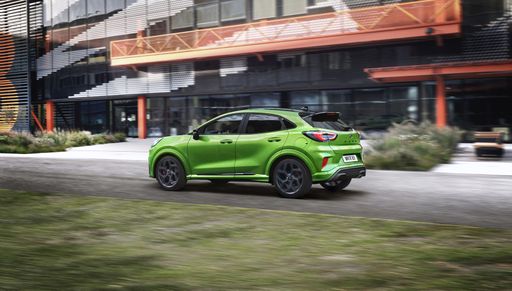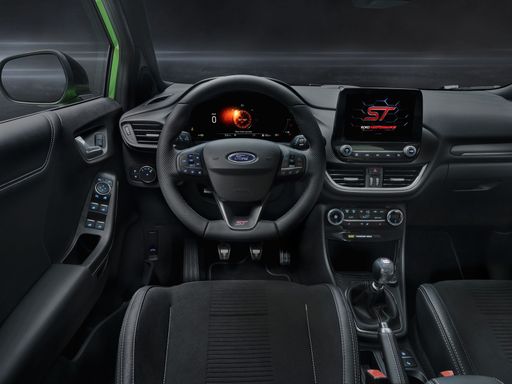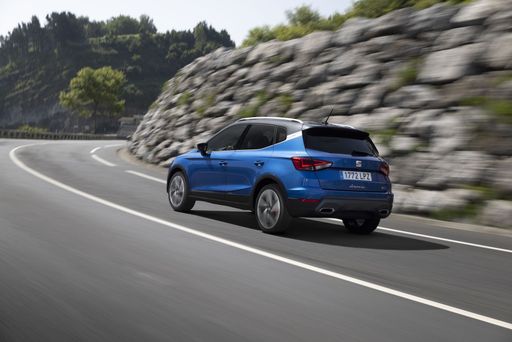When it comes to the burgeoning compact SUV market, two models are making significant waves: the Ford Puma and the SEAT Arona. Both vehicles boast modern designs, efficient engines, and a host of cutting-edge technologies, making them worthy contenders in their segment. This article provides a comprehensive comparison of these two popular models, focusing on technical specifications, performance metrics, and innovative features.
Ford Puma vs SEAT Arona – Which model is better for everyday use?
Everyday use, family trips or long-distance drives – here’s where the differences show.
Discover whether Ford Puma or SEAT Arona fits your lifestyle better.
Powertrains and Performance
The Ford Puma offers a range of options that cater to different preferences and driving styles. With engine choices including petrol MHEV (Mild Hybrid Electric Vehicle) variants, the Puma provides power outputs that range from 125 to 168 HP. Its acceleration capabilities also impress, with times as low as 7.4 seconds for the 0-100 km/h sprint. In terms of efficiency, the Puma showcases a remarkable fuel consumption range of 5.4 to 6 L/100 km, which is competitive in its class.
On the other hand, the SEAT Arona is powered exclusively by petrol engines, with power outputs ranging from 95 to 150 HP. It demonstrates solid performance, reaching 0-100 km/h in as low as 8.4 seconds with the more powerful engine option. The Arona's fuel consumption is comparable to the Puma, with values ranging from 5.4 to 5.6 L/100 km. Both models utilize front-wheel drive layouts, although the Puma’s hybrid variant may offer additional efficiency benefits in certain driving conditions.
Dimensions and Cargo Space
In terms of size, the Ford Puma measures between 4186 mm to 4226 mm in length, 1805 mm wide, and has a height of 1550 to 1555 mm. It provides ample trunk capacity ranging from 456 to 523 liters, making it practical for everyday use or family outings.
The SEAT Arona, while slightly smaller with a length of 4153 mm and a width of 1780 mm, still manages to offer competitive space. Its trunk capacity sits at a respectable 400 liters. While it may not surpass the Puma in cargo volume, the Arona’s compact size can be advantageous for city driving and parking.
Technological Innovations
Ford has incorporated multiple technological advancements into the Puma, including an advanced infotainment system that supports Android Auto and Apple CarPlay. Additionally, its hybrid powertrain features regenerative braking technology, which enhances energy efficiency. The Puma also boasts a 43 kWh battery on its electric variants, allowing for an electric range of up to 376 km.
SEAT, on the other hand, emphasizes connectivity and driver assistance systems in the Arona. It features a user-friendly infotainment system, along with multiple connectivity options. While SEAT may not offer a hybrid variant, the Arona is designed to be light and nimble, affording a dynamic driving experience.
Driving Experience and Comfort
The driving experience in both vehicles is designed to be engaging and comfortable. The Ford Puma is equipped with features like adaptive cruise control, lane-keeping assistance, and enhanced suspension that caters to both spirited drives and daily commutes. It is built with a focus on comfort, promising a smooth ride regardless of road conditions.
The SEAT Arona offers a similarly inviting driving experience, with responsive steering and a well-tuned suspension system. The cabin benefits from quality materials and ergonomic design, ensuring passengers enjoy a comfortable journey. While it leans towards a sporty feel, the Arona does not compromise on comfort.
Conclusion
In conclusion, the Ford Puma and SEAT Arona each offer unique advantages and appeal to different types of drivers. The Puma stands out with its hybrid offerings and superior cargo space, while the Arona shines in its dynamic driving experience and connectivity features. Ultimately, the choice between these two compact SUVs will depend on individual preferences regarding efficiency, space, and driving style. Regardless, both models are illustrious representations of their brands, setting high standards in the competitive compact SUV market.
Here’s where it gets real: The technical differences in detail
Costs and Efficiency:
Price and efficiency are often the first things buyers look at. Here it becomes clear which model has the long-term edge – whether at the pump, the plug, or in purchase price.
SEAT Arona has a distinct advantage in terms of price – it starts at 19300 £, while the Ford Puma costs 24800 £. That’s a price difference of around 5469 £.
Both cars consume an average of 5.40 L per 100 km – no difference here.
Engine and Performance:
Under the bonnet, it becomes clear which model is tuned for sportiness and which one takes the lead when you hit the accelerator.
When it comes to engine power, the Ford Puma has a to a small extent edge – offering 168 HP compared to 150 HP. That’s roughly 18 HP more horsepower.
In acceleration from 0 to 100 km/h, the Ford Puma is somewhat quicker – completing the sprint in 7.40 s, while the SEAT Arona takes 8.40 s. That’s about 1 s faster.
There’s no difference in top speed – both reach 210 km/h.
There’s also a difference in torque: Ford Puma pulls somewhat stronger with 290 Nm compared to 250 Nm. That’s about 40 Nm difference.
Space and Everyday Use:
Beyond pure performance, interior space and usability matter most in daily life. This is where you see which car is more practical and versatile.
Both vehicles offer seating for 5 people.
In curb weight, SEAT Arona is to a small extent lighter – 1188 kg compared to 1316 kg. The difference is around 128 kg.
In terms of boot space, the Ford Puma offers distinct more room – 523 L compared to 400 L. That’s a difference of about 123 L.
In maximum load capacity, the Ford Puma performs minimal better – up to 1283 L, which is about 3 L more than the SEAT Arona.
When it comes to payload, SEAT Arona slightly takes the win – 522 kg compared to 469 kg. That’s a difference of about 53 kg.
Who wins the race?
The SEAT Arona proves to be shows small but notable strengths and therefore becomes our DriveDuel Champion!
SEAT Arona is the better all-rounder in this comparison.
 @ SEAT S.A. / SEAT Media Center
@ SEAT S.A. / SEAT Media Center
SEAT Arona
Ford Puma
The Ford Puma is a cheeky compact crossover that blends sporty styling with city-friendly practicality, giving drivers a surprisingly fun and composed ride. With clever storage tricks and a lively personality, it’s a smart pick for buyers who want enjoyment without fuss.
details @ Ford Motor Company / Ford Media Center
@ Ford Motor Company / Ford Media Center
 @ Ford Motor Company / Ford Media Center
@ Ford Motor Company / Ford Media Center
 @ Ford Motor Company / Ford Media Center
@ Ford Motor Company / Ford Media Center
 @ Ford Motor Company / Ford Media Center
@ Ford Motor Company / Ford Media Center
SEAT Arona
The SEAT Arona is a cheeky urban crossover that mixes sharp styling with sensible practicality, making it an appealing choice for buyers who want personality without fuss. It’s zippy in traffic, comfortable enough for daily driving, and brings enough character to make routine journeys feel a little more fun.
details @ SEAT S.A. / SEAT Media Center
@ SEAT S.A. / SEAT Media Center
 @ SEAT S.A. / SEAT Media Center
@ SEAT S.A. / SEAT Media Center
 @ SEAT S.A. / SEAT Media Center
@ SEAT S.A. / SEAT Media Center
 @ SEAT S.A. / SEAT Media Center
@ SEAT S.A. / SEAT Media Center
 @ Ford Motor Company / Ford Media Center
@ Ford Motor Company / Ford Media Center
|
 @ SEAT S.A. / SEAT Media Center
@ SEAT S.A. / SEAT Media Center
|
|
|
|
Costs and Consumption |
|
|---|---|
|
Price
24800 - 36300 £
|
Price
19300 - 29300 £
|
|
Consumption L/100km
5.4 - 5.9 L
|
Consumption L/100km
5.4 - 5.6 L
|
|
Consumption kWh/100km
13.1 - 13.9 kWh
|
Consumption kWh/100km
-
|
|
Electric Range
361 - 376 km
|
Electric Range
-
|
|
Battery Capacity
43 kWh
|
Battery Capacity
-
|
|
co2
0 - 135 g/km
|
co2
122 - 128 g/km
|
|
Fuel tank capacity
42 L
|
Fuel tank capacity
40 L
|
Dimensions and Body |
|
|---|---|
|
Body Type
SUV
|
Body Type
SUV
|
|
Seats
5
|
Seats
5
|
|
Doors
5
|
Doors
5
|
|
Curb weight
1316 - 1563 kg
|
Curb weight
1188 - 1268 kg
|
|
Trunk capacity
456 - 523 L
|
Trunk capacity
400 L
|
|
Length
4186 - 4226 mm
|
Length
4153 mm
|
|
Width
1805 mm
|
Width
1780 mm
|
|
Height
1550 - 1555 mm
|
Height
1537 mm
|
|
Max trunk capacity
1216 - 1283 L
|
Max trunk capacity
1280 L
|
|
Payload
367 - 469 kg
|
Payload
502 - 522 kg
|
Engine and Performance |
|
|---|---|
|
Engine Type
Electric, Petrol MHEV
|
Engine Type
Petrol
|
|
Transmission
Automatic, Manuel
|
Transmission
Manuel, Automatic
|
|
Transmission Detail
Reduction Gearbox, Manual Gearbox, Dual-Clutch Automatic
|
Transmission Detail
Manual Gearbox, Dual-Clutch Automatic
|
|
Drive Type
Front-Wheel Drive
|
Drive Type
Front-Wheel Drive
|
|
Power HP
125 - 168 HP
|
Power HP
95 - 150 HP
|
|
Acceleration 0-100km/h
7.4 - 9.8 s
|
Acceleration 0-100km/h
8.4 - 11.3 s
|
|
Max Speed
160 - 210 km/h
|
Max Speed
182 - 210 km/h
|
|
Torque
170 - 290 Nm
|
Torque
175 - 250 Nm
|
|
Number of Cylinders
3
|
Number of Cylinders
3 - 4
|
|
Power kW
92 - 124 kW
|
Power kW
70 - 110 kW
|
|
Engine capacity
999 cm3
|
Engine capacity
999 - 1498 cm3
|
General |
|
|---|---|
|
Model Year
2025
|
Model Year
2025
|
|
CO2 Efficiency Class
A, D
|
CO2 Efficiency Class
D
|
|
Brand
Ford
|
Brand
SEAT
|
Is the Ford Puma offered with different drivetrains?
The Ford Puma is offered with Front-Wheel Drive.
The prices and data displayed are estimates based on German list prices and may vary by country. This information is not legally binding.
